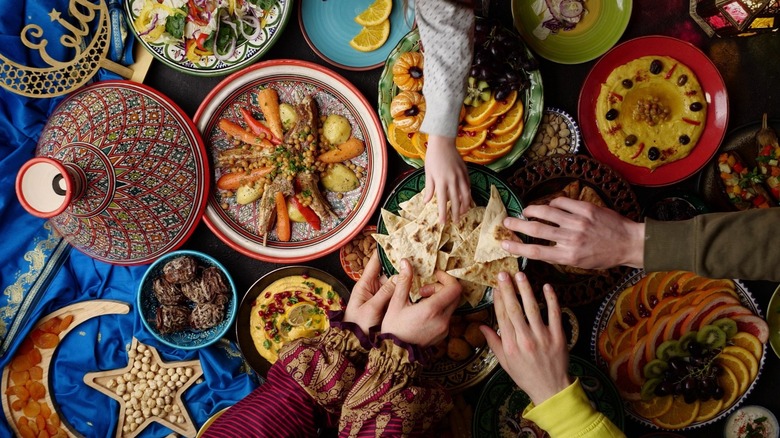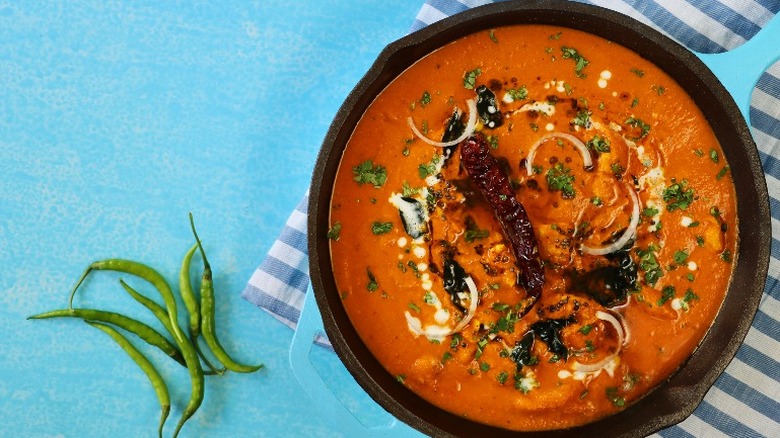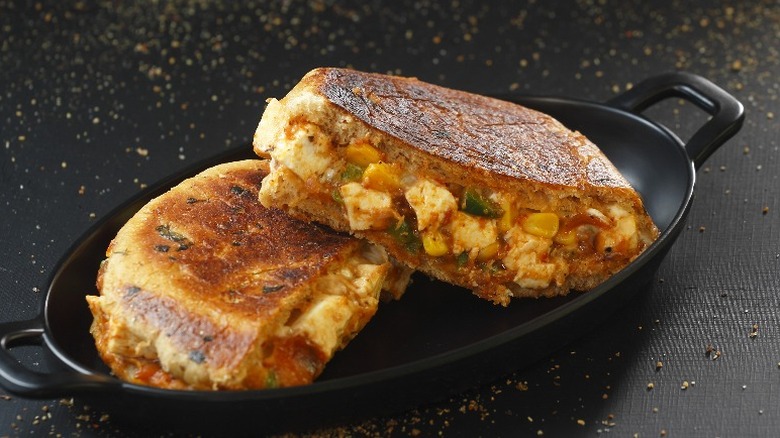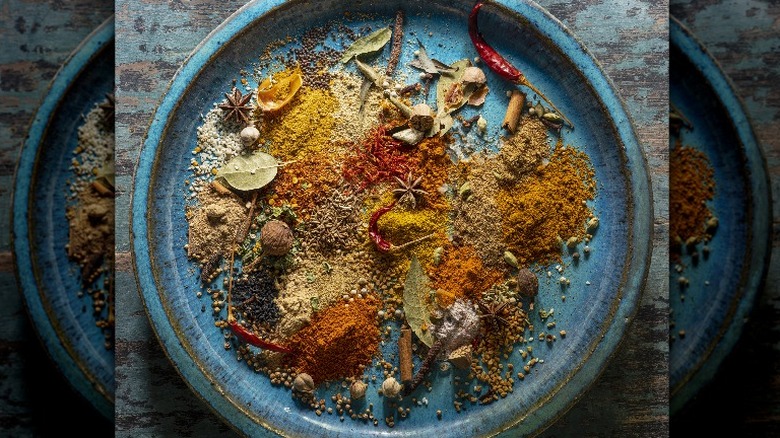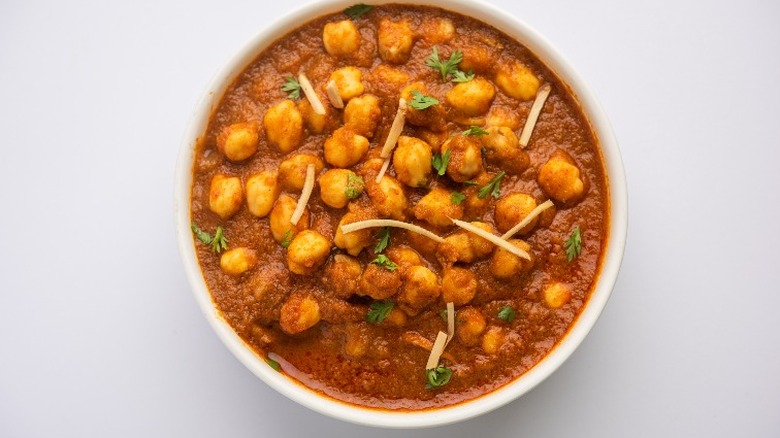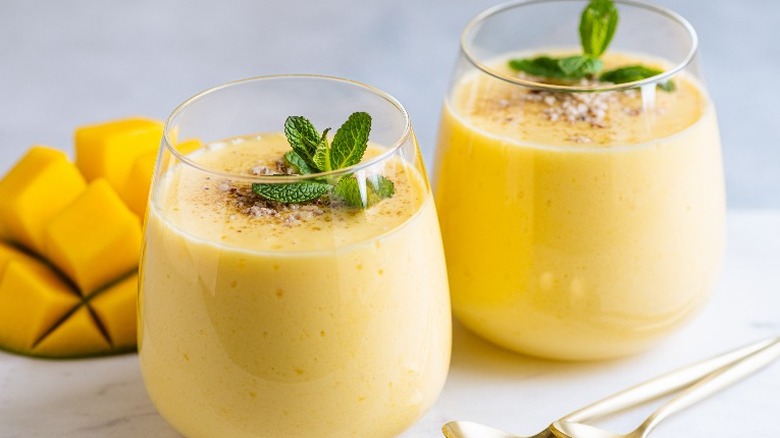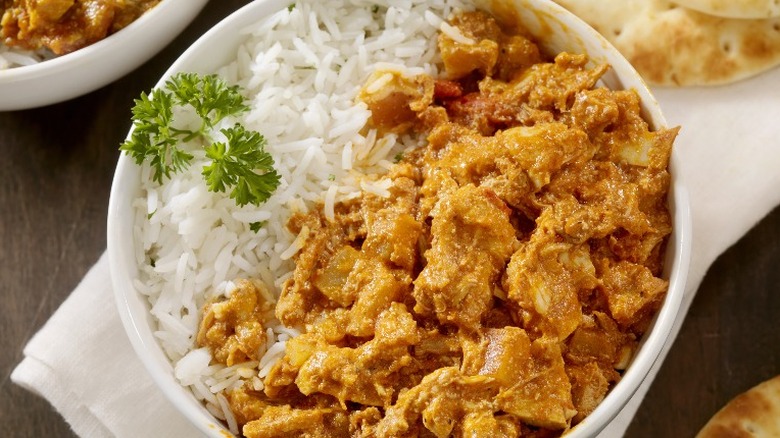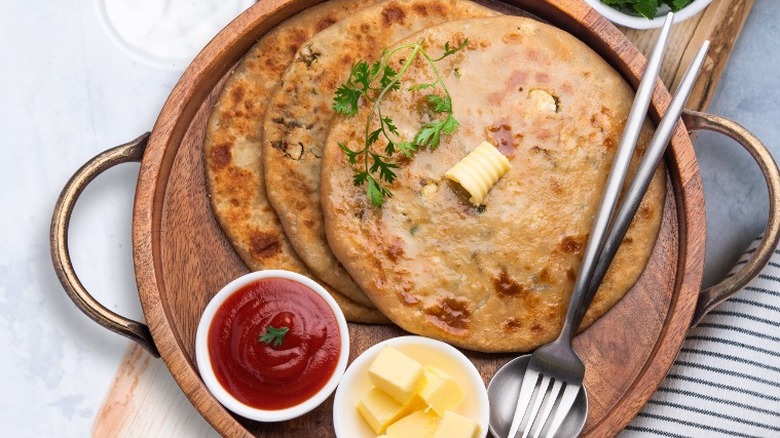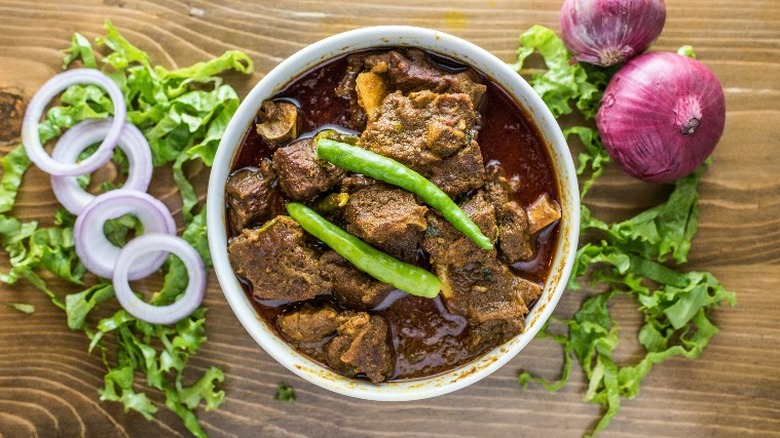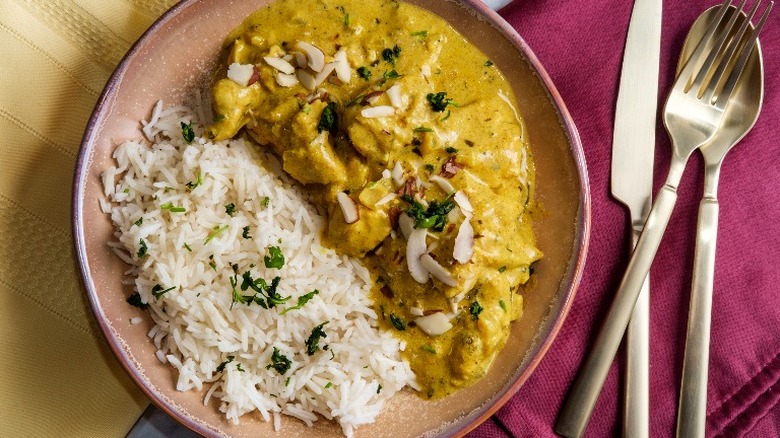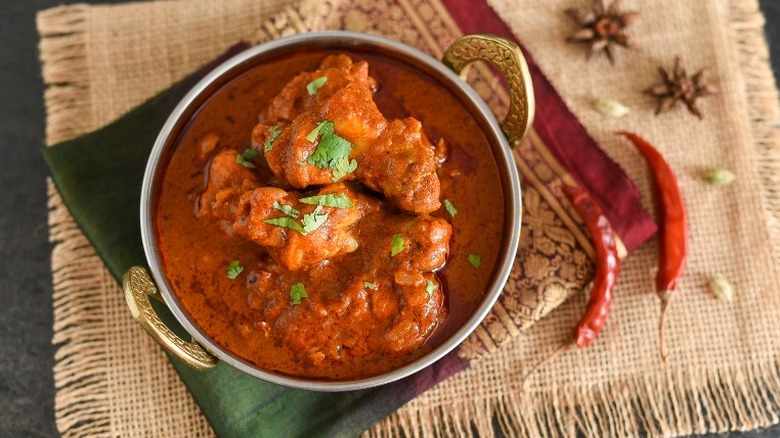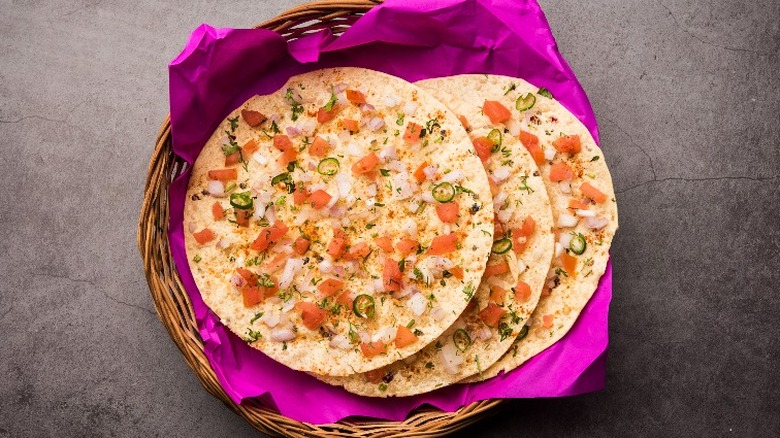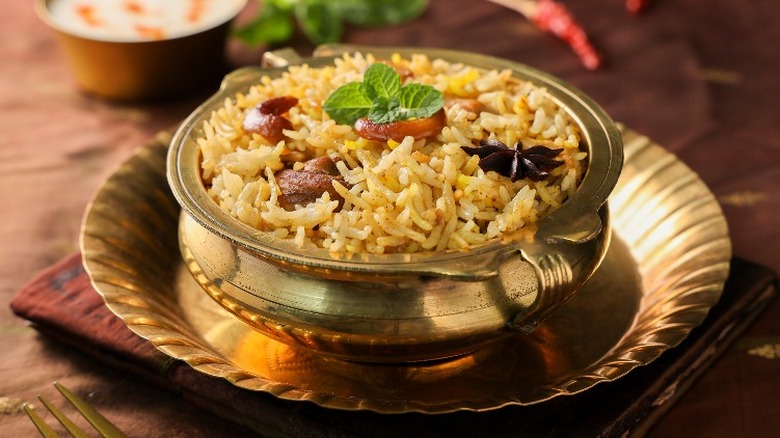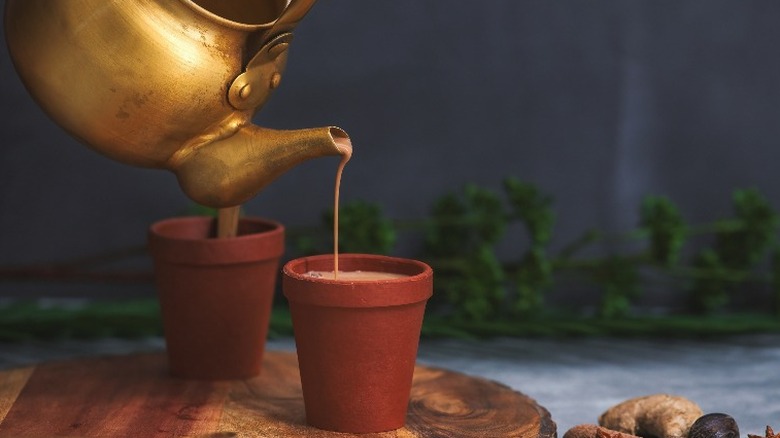13 Words And Phrases To Know When Eating At An Indian Restaurant
Whether you rely on takeout or enjoy dining at Indian restaurants, they offer a wide variety of delicious meals. Though many Indian restaurants offer convenient translations of their menus, the language barrier may limit some dining experiences. Knowing a few key terms, translations, and phrases can make navigating an Indian restaurant menu much simpler. By boosting your culinary vocabulary, you may feel more confident ordering dishes beyond your go-to meal.
Many Indian restaurants include English translations of popular dishes, but knowing what keywords like masala or Hindi translations for meat options will broaden your dining horizons. Indian cuisine is vast and filled with exciting flavors, ingredients, and combinations that may be unfamiliar. So, learning a bit about how to read the menu could be immensely helpful. Knowing basic vocabulary on Indian menus also shows respect for the dining experience and the variety of food that branches from the culture. Not only will you learn more about Indian food, but you'll build the understanding needed to expand your palette.
1. Murgh means chicken
Sticking to what you are familiar with is a common practice for English speakers dining at international restaurants. Many know what dishes like butter chicken or chicken karahi are because the main meat ingredient is listed in the name. However, sticking to what you know and not asking questions, you could miss out on incredible dishes like murgh malaiwala.
Additionally, knowing the definition of the Hindi word can assist when navigating menus that do not include English translations. So, when searching for butter chicken and garnering no success, look for murgh makhani, which is the traditional name for the dish. Many restaurants section off their meals by meat, cooking type, spice blend, or course. If you want to order a chicken dish, simply scope out the menu sections and look for chicken or murgh. This can also serve vegetarians and vegans diners, as it will help to know what dishes and sections of Indian restaurant menus to avoid.
2. Paneer means cheese
When searching for a hearty and delicious meal at an Indian restaurant, many diners may not realize that one of their favorite foods is featured in several dishes. Paneer is a component of popular dishes such as palak paneer (a spinach gravy with paneer) or paneer samosas. Paneer is an unaged soft cheese that does not melt like many other cheeses and is sometimes compared to Mexican queso blanco or feta cheese.
Paneer is made by boiling whole milk with citrus juice (typically lemon) and cooking until curdled. After that, Paneer is strained and squeezed into a smooth block. Paneer is used in a multitude of ways in Indian cooking; it can top dinner dishes, be fried into delicious snacks or appetizers, and also be sprinkled into egg scrambles for a dose of cheesy goodness in your breakfast. Knowing what Paneer is and how it is used helps navigate an Indian restaurant menu. It can especially help people with dairy intolerances or those following vegan diets who may not understand that Paneer is a dairy-based product.
3. Masala is spice blend
Chicken masala, bhindi masala, and chana masala are popular dishes enjoyed by many. However, some diners may fail to understand that Masala indicates the use of a common spice blend rather than a cooking practice or ingredient and comprises coriander, cumin, cardamom, cinnamon, cloves, and black pepper. Other spices like nutmeg or anise can be included but are not the primary flavors of masala blends. The spices are toasted to enhance the aromatics and then ground into a fine powder used in curries, sauces, soups, or teas.
Masala is incredibly popular and used in many dishes. It is often ground into a wet paste with onions and used as a starter for soups or sauces. Many Indian dishes are considered spicy, and some restaurants will even ask customers if they want their dishes to be prepared at a mild or hot spice level before preparing them. Masala, however, is not necessarily a heating spice but provides a warmer, more aromatic experience.
4. Chana means chickpea
Chickpeas are a common ingredient in Indian cooking. The region's cuisine often accommodates vegetarianism, so chickpeas provide a hearty protein alternative in many dishes. Some Indian restaurant menus will use the English translation, and others will use chana, the Hindi term. Whether you love them or are seeking a meatless option, scoping out menus for the word chana will lead you in the right direction.
Chana masala is one of the more popular Indian dishes made with chickpeas. Similar to chicken masala, chickpeas are cooked with aromatic spices, tomatoes, and onions, and served on a bed of rice. Chickpea salads are sometimes offered on Indian restaurant menus and typically include fresh cucumbers, onions, and spice blends that pair with chickpeas to make a delightful side or appetizer. Chana pulao is a rice dish that cooks chickpeas with basmati rice, onions, tomatoes, and spices like saffron, turmeric, and masala blends. It is either served as an independent dish or with a curry or meat.
Chickpeas are an incredibly versatile ingredient in Indian cooking. Whether the main component of a dish or mixed with other ingredients, they contribute to the accessibility Indian cooking creates for people following meatless diets.
5. Lassi is a yogurt drink
Pairing a savory dish like bhindi masala or red curry with a cooling beverage can transform the full experience of the meal. Lassi is a drink that appears on many Indian restaurant menus in which the primary ingredient is yogurt. There are multiple variations of the drink which can include sugar, spices, fruits, and toppings. And, the drink can be sweet or savory.
Lassi is typically prepared using a blender or a wooden churner, similar to those used for making buttermilk. The process begins with whisking the yogurt until it is frothy, and then adding other ingredients until smooth. Popular variations of the drink include mango lassi, which incorporates sweetness from the fruit. Namkeen lassi, or "salted lassi," uses black salt and cumin to accompany the yogurt. Meethi lassi, or "sweet lassi," uses sugar, cardamom, saffron, and sometimes rosewater to craft a rich and creamy beverage.
Restaurants may use different spice blends for their lassi recipe, but menus will typically indicate if the drink can come sweet, spicy, or with fruit. No matter the variation, lassi is a great drink that may cool down taste buds after a spicy meal.
6. Tikka means the dish contains small chunks of meat
Chicken tikka masala might be one of the more popular dishes in the Indian cooking tradition and is a staple on most Indian restaurant menus. Tikka infers more about how the meal was prepared than the specific ingredients in the dish. It simply means that the dish contains small chunks of meat cut up into edible pieces. Some legends say that the dish was historically prepared by cooking larger pieces of meat, but some powerful leaders desired the meat to be cut into small pieces for fear that they would choke on bones. In the '70s, chef Ali Ahmed Aslam brought chicken tikka masala to the United Kingdom by serving it at his restaurant, according to CNN. Today, the dish is incredibly popular and is often hailed as a national British dish.
Chicken tikka masala is prepared in most modern Indian restaurants beginning by marinating small chunks of chicken thighs or breasts in a yogurt-based marinade with spices like ginger, masala blends, turmeric, chili, and cumin. The marinated chicken is then added to a pan with more spices. After the chicken is cooked, a sauce made of pureed tomatoes, butter, onions, and thickened cream coats the chicken bites. The final product is served on rice, and dipping naan bread into the sauce ensures that every delicious bite is eaten.
7. Aloo means potato
Potatoes are an essential ingredient in many different food traditions. Indian restaurants feature spuds in delicious, creative ways. Many Indian restaurants use rice as the primary starch in meals, but certain dishes use potatoes as a carbohydrate. And, aloo indicates on Indian restaurant menus that the dish contains potatoes.
Paratha is a flaky unleavened flatbread served as a side at many Indian restaurants. A popular variation is aloo paratha, which is a flatbread stuffed with a mashed potato mixture and spices cooked with butter or ghee. Aloo palak, a spinach and potato curry, often appears on restaurant menus. Sometimes it is served with rice or a bread like naan to scoop up the delicious curry. Aloo gobi is another curry that uses potatoes and cauliflower to create a dish that typically features flavors like cumin, coriander, and masala blends.
However, one of the most popular potato dishes in Indian restaurants typically doesn't include the word aloo. Samosas are a beloved appetizer in Indian cooking. Fried pastry dough is stuffed with a filling made of spiced mashed potatoes, peas, onions, and sometimes meat. Served with chutney for dipping, these snacks are a delicious fried treat that most Indian restaurants offer.
8. Bhuna means the food was fried
Bhuna is another word on Indian restaurant menus that does not indicate ingredients or flavor, but rather the cooking method used to create the dish. Bhuna means that the spices and seasoning used in the dish were fried in fat like oil, butter, or ghee. Sometimes ingredients like garlic, chiles, onions, or tomatoes are fried with the spices. The ingredients are cooked into a thick paste serving as a starter in certain curries or soups. After the paste is formed, it can transform dishes with rich, vibrant flavors that have time to develop through frying.
Bhuna gosht is a dish prepared by frying lamb or mutton in the Bhuna paste to create a thick and luxurious dish that is often paired with rice or naan bread. Chicken bhuna is also popular on restaurant menus; chicken is fried in spiced paste, and the crispy result is served on rice. Different spice combinations are used depending on the restaurant, but most bhuna pastes will include chili, ginger, turmeric, cumin, and masala blends.
Bhuna dishes are varied, but the frying method results in juicy meat packed with intense, rich flavors. It can vary between restaurants if you are curious about what bhuna gosht or chicken bhuna is served with. Asking the server will let you know if it is served with naan bread or rice.
9. Korma implies a dish cooked with yogurt
Many Indian dishes on restaurant menus have thick, rich, and creamy sauces that make you crave it time and time again. One dish with those unmistakably luxurious flavors is korma. Korma is a dish that braises meat or vegetables in cream, yogurt, spices, and stock. The historical roots of the dish are attributed to Mughlai cuisine developed through combinations of Indian and Persian cooking techniques. The dish was created to be served to royals and wealthy elites.
The braising process is important to create the perfect korma; the juices from the meat combine with the yogurt to make a flavorful sauce. Sometimes the meat is marinated prior to cooking in a mixture of nut butter, yogurt, and spices. The meat (or vegetables) is cooked with stock or cream added to liquidize the gravy a bit more. Chicken korma is the most popular variation of the dish, but vegetarian kormas usually have potatoes, peas, bell peppers, and carrots.
10. Vindaloo is a dish with a spicy sauce
Vindaloo is a dish that centers around vindaloo sauce. Coconut milk, vinegar, and spices like paprika, cumin, chilis, ginger, garlic, cayenne pepper, and ground mustard combine to create this often spicy dish. The sharp and fiery sauce is usually combined with meats and vegetables to make a curry dish served with rice. It has a distinctive reddish-orange hue that stands out from other dishes.
Meats like pork, chicken, and lamb are popularly marinated or cooked in the sauce. Meatless vindaloos will sometimes contain beans, tofu, or vegetable blends including cauliflower, mushrooms, and potatoes.
Many Indian restaurants will ask diners how spicy they want their dish to be prepared. Some restaurants even devise numeric scales of heat levels that diners share with their server to pass along to the kitchen. This is because many Indian dishes, like vindaloo, contain flavors like chili, ginger, and spicy masala that could seriously attack the taste buds of people unfamiliar with spice!
11. Papad, or Papadum, is a thin wafer cracker
Lentils are frequently used in Indian cooking and one dish that celebrates this little legume is the papad or papadum. This menu item on Indian restaurant menus is a crispy cracker or flatbread made of dried lentils. Similar to chips, papad is a light and crunchy snack that sometimes accompanies a main dish or is served as an appetizer. The dough is made with dried lentil flour, peanut oil, and spices. After the dough is pressed into a thin circular shape, they are either dried or fried.
Indian restaurants may feature papads with an array of chutneys as an appetizer. Chutney is a sauce or spread used in many different Indian recipes. There are many varieties of chutney, but restaurants will sometimes serve three different chutneys together on a tasting platter. Tamarind chutney, a sweet and tangy variation, mint cilantro chutney, and red chutney, with chilis and gals, are served with papad often. Papad can be dipped into the different chutneys to taste what each of them has to offer.
Masala papad is another snack using fried papad topped with onions, tomatoes, chilies, cilantro, and spices to create a flavorful snack. Papad is also sometimes crushed on top of soups as a crunchy garnish.
12. Biryani is a fried rice dish
Biryani is a historically beloved dish in Indian cuisine."There can be little doubt that biriyani originated in Iran. Even the name biriyani can be traced to the original Persian 'birinj biriyan' — literally, fried rice," according to the BBC. The dish traditionally involves basmati rice, spices, meat, and a marinade, though the variations of the dish are vast.
Kolkata biryani is a dish hailing from the city of Kolkata, in eastern India. This popular variety of biryani is mild rice that includes basmati rice, onions, potatoes, and occasionally chicken or eggs. The most popular meat that is incorporated into the dish is chicken. It also regularly uses rosewater and saffron in the frying process to give it its signature flavor. Ambur biryani is a variation that uses fewer spices, so the meat flavors are more prominent. It also uses jeeraga samba rice with mint leaves, coriander, cloves, and cinnamon. Some biryani recipes will include dried fruit for an exciting flavor profile.
13. Chai means tea
Chai by itself typically refers to any kind of tea, making the term chai tea somewhat redundant. Masala chai is a specific kind of tea that pairs nicely with Indian dishes or as a post-meal nightcap. Masala chai is made by simmering black tea with milk, sugar, and additional spices like ginger, fennel, nutmeg, and star anise. This delicious beverage is usually served hot. Masala chai is not to be confused with a chai latte; the latte variation is prepared by pouring the steeped chai brew into steamed, frothy milk.
Another popular chai is the Kashmiri-style Noon Chai. This bright pink beverage is prepared by brewing special tea leaves with milk, baking soda, and sometimes dried fruit and rose petals. This aromatic drink is frothy, tasty, and pretty to look at. Golden Chai is a tea known for its bright yellow color that comes from the turmeric-heavy blend. Typically, turmeric is added to warm, frothy milk to craft a comforting brew.
